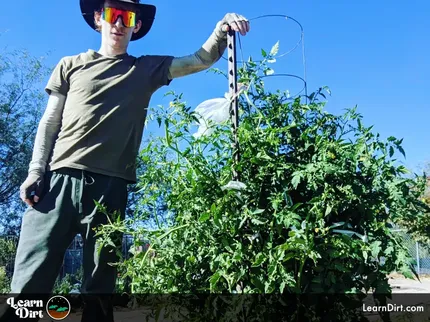Table of Contents
- What Is Cured Compost?
- Do You Have to Cure Your Compost?
- Curing Compost
- Compost Curing Tips
- How to Use Cured Compost
* Our articles never contain AI-generated slop *
I'm consistently surprised by how little thought, effort, time, attention, and resources many organic gardeners are willing to put into their compost systems - as if it were just a mere afterthought to gardening.
Entire gardens served by 1 small tumbler. This is a misalignment of priorities in my opinion, and will compromise much of the possibility of achieving incredible result in the garden.
Disclaimer: This post may contain affiliate links. Refer to the privacy policy for more information.
Without being able to produce enough of your own compost for gardening, you'll be heavily reliant on store-bought compost whose quality will not compare to what you could produce.
Compost is one of the cornerstone skillsets which powers organic gardens. Moreover, composting is gardening. It's not something separate from it. If you're going to be good at organic gardening, you're going to need to be good at composting.
Not to worry, though, you are here learning about compost, because you want to grow and improve your gardening skillset. You're doing your research and absorbing all the knowledge you can so that you can produce incredible compost which will help power your indredible garden!
What Is Cured Compost?
So we know compost is super important, but what's the deal with cured compost?
What exactly is the compost curing process, how does it work, and is it important?
Do You Have to Cure Your Compost?
Definitely not, curing is not required for compost (with caveats).
While it's not required, curing your compost before use will give you better results across a wider range of uses.
For instance, cured compost will be a lot more gently on your seedlings when used in homemade seed-starting mix than uncured compost will be. If you intend to use your compost as a constituent on your own seed-starting mix, I recommend curing it for at least a few weeks before use if possible.
Curing Compost
Now for the fun part, let's get into just how exactly the compost curing process works.
To cure your compost, you will need to let it sit for several weeks or months. During this time, you should turn the pile occasionally to ensure that it breaks down evenly and to promote aeration.
I usually cure in plastic storage totes or trash cans with a few small holes punched for drainage and aeration.
Sift / Screen Your Compost
Sifting or screening your compost is the way to remove all the big chunks and clumps from it. This gives you a finer texture that's easier to utilize in seed-starting and potting mixes.
While sifting is an important step before use, I like to sift my compost before curing as well.
After the compost process, remaining clumps tend to be more wet, bioactive, and nitrogenous than the rest of the compost.
I find these clumps do better when they're redirected back through the compost system for another go-around, rather than sit in my curing compost.
By removing the wet bioactive clumps, the overall moisture and bioactivity levels of the compost are reduced. This sets you up for the perfect cure, as compost has a chance to "chill out" and dry back for a while before use.
Join The Grower's Community
A FREE, friendly forum
where you can ask questions,
swap tips, and meet like-minded growers 🌱
Check It Out!
I screen out all my compost on 1/4" hardware cloth, and love that I can put 2 pieces on top of each other misaligned slightly for a finer sift. 1 or 2 squares of this can sit on top of a tote or wheelbarrow for easy compost sifting.
Reduce Moisture Level
As your compost cures, you can allow it to slowly become more dry.
I like to gradually dry my compost out as it finishes, prior to sifting and curing.
Aim for the moisture level you would find in a bag of store-bought compost or soil - slightly moist but not damp
This will slowly reduce the level of biological activity in the compost as well, making it more reasonable to use for seedlings and starts.
Dryer compost is easier to sift.
Dryer compost breaks down slower, which facilitates a slow curing process which is ideal.

Monitor Bioactivity
Check out our article on Controlling Compost Bioactivity to learn more about bioactivity levels.
Continue Turning It
Curing compost does not require as much turning as active compost, but will still benefit from it.
While technically no compost ever has to be turned, it helps to oxygenate the pile, boosting activity levels of aerobic bacteria and microbes.
Dig Cool Merch?
For small piles, a compost crank is great for this. Larger piles you'll have to get our your pitchfork, find some friends to help, or size up to the heavy machinery.
If you've got a compost tumbler, just give it a good spin.
Be Patient
While there is no set amount of time for compost to be considered "well-cured", I like to cure mine for 2-3 months when possible.
The longer the better in this case, though it takes time to get far enough ahead on your composting. Year 1 you might not have time to let compost cure, while year 4 might see you curing compost for 6 months before use. It depends entirely on how far ahead you are on your compost.
This is yet another reason to never stop composting!
It's also a great idea to invest in a multi-bay or multi-stage system so that you are always working more compost through the system and have numerous piles at different ages and levels of cure. Multiple tumblers work great, as do multi-stage pallet or brick bay systems.
Compost Curing Tips
How to Use Cured Compost
Once your compost is fully cured, it's ready to use.
My favorite use for cured compost is as an ingredient in my homemade seed starting mix.










![Black Dirt Live Again [Blue]](/media/product_images/black-dirt-live-again-[blue]_shirt_260x260.png)















![Black Dirt Live Again [Purple] T-shirt](/media/product_images/black-dirt-live-again-[purple]_shirt_260x260.png)








Leave A Comment:
Under construction, please check back soon!